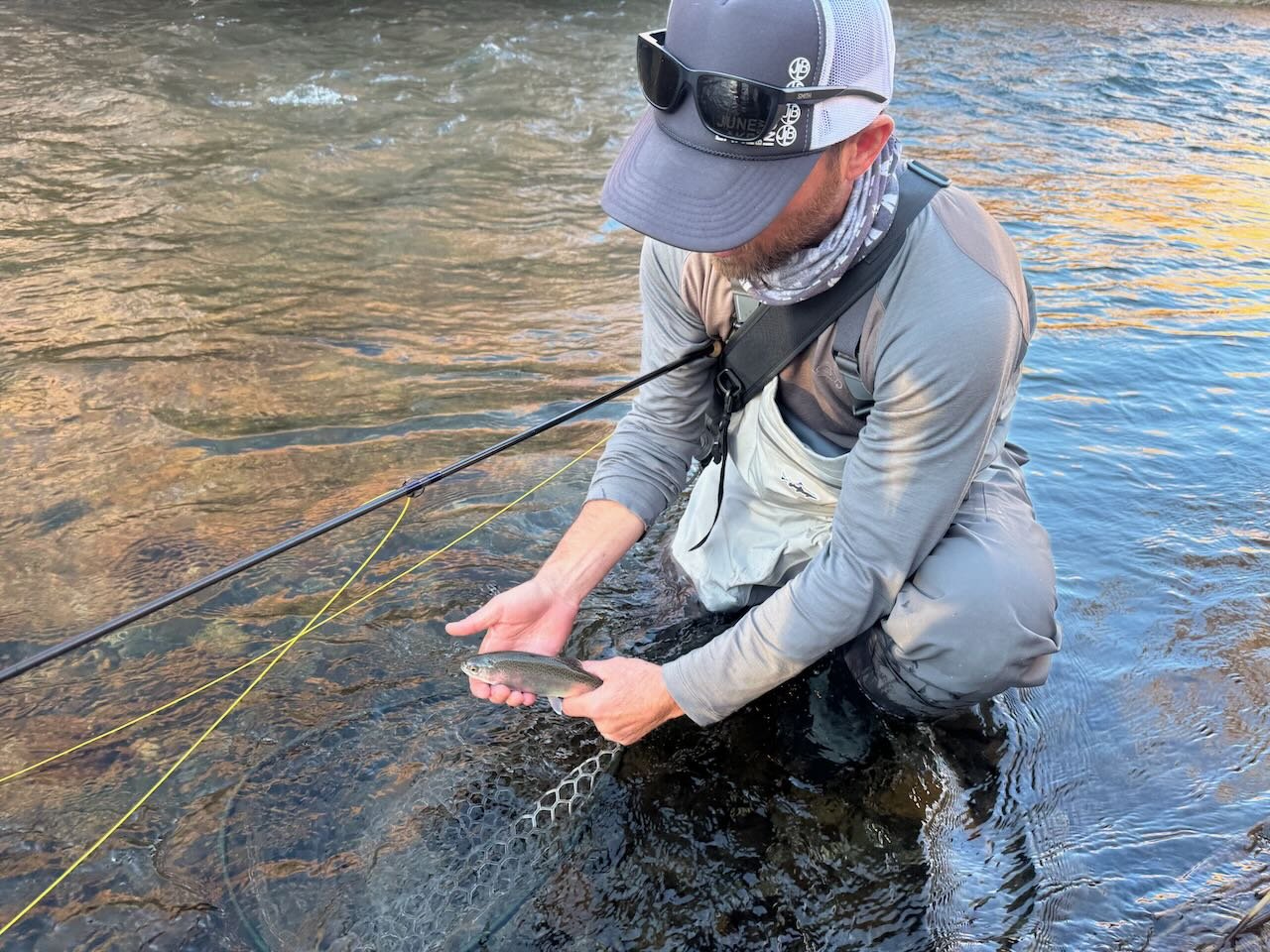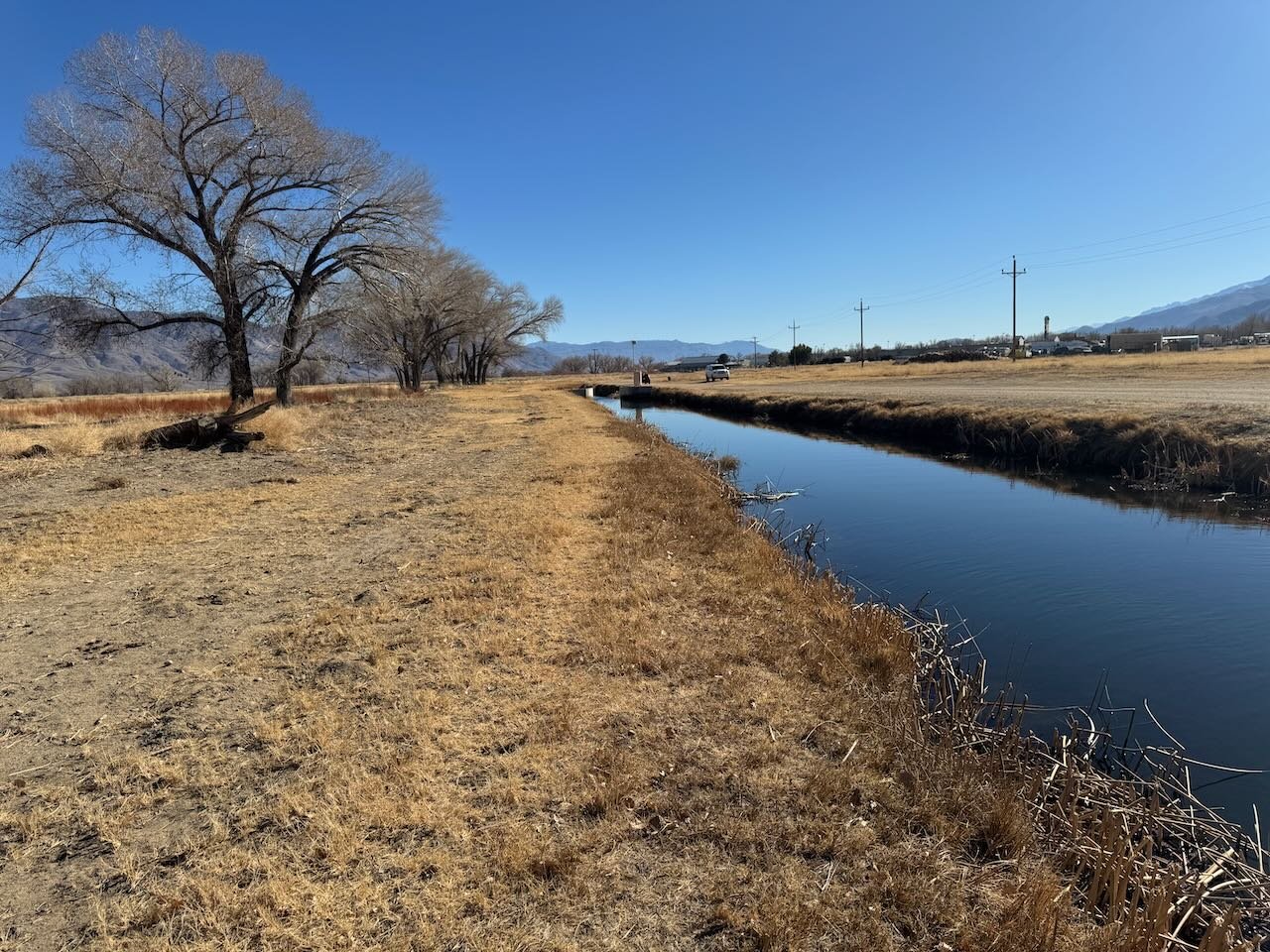If you are looking for tips on fly fishing techniques on Eastern Sierra waters, upcoming events and where the best Eastern Sierra weekend fly fishing spot is, sign up for the email on the webpage at https://www.sierrabrightdot.com
We are in a maybe get some snow in the upper elevations weather pattern. Look for the possibility of snow over the weekend. Owens Valley got an inch or two of snow last weekend, but once the sun comes out the snow is gone. As we leave January and head into February I expect the fishing to pick up. As daylight increase so will the hatches. As the hatches intensify it will bring consistently rising trout to the surface. Mayflies, stoneflies, caddisflies and midges are the insects feeding the trout. If you are on the right water at the right time you will see sporadic surface feeding trout.
The only snow left in the Owens Valley is protected in the shadows of north facing willows and tulles on the lower Owens River.
Lower Owens River
Wild Trout Section:
There are fish to be caught, but fly fishers nymphing are working really hard for a few trout. With the cold water the trout are not aggressively taking the nymphs. The slightest movement in the indicator and the fly fisher needs to setting the hook. It’s better to over set than not set. As the saying goes sets are free. Midges, stoneflies and mayflies are the insects the trout are feeding on. Use size 12 stoner nymphs or size 14 copper John’s to imitate the winter Skwala stoneflies. Use size 18 or 20 midge pupae and midge nymph patterns in tiger, zebra or blood coloration. For the blue wing olive mayfly nymphs nymph with size 18 olive quilldigons, size 18 bead head flash back pheasant tail nymphs, size 16 hot spot pheasant tail nymphs, size 18 brown or olive SOS nymphs and size 18 jedi master bateis nymphs. Carry a few size 18 blue wing olive parachutes, size 18 Adams parachutes and size 18 olive sparkle duns to imitate the hatching blue wing olive duns when the trout are sipping flies off the rivers surface.
Tim Louis from Redwood City with a wild rainbow trout from the wild trout section of the lower Owens River.
Hot Creek
Interpretive Site:
The recent snow storm did not leave enough snow on the ground to inhibit vehicle access to the Hot Creek Interpretive Site. This area fly fishes best when there are hatches going on. Middle of the day is seeing trout feeding on tiny midges. Nymphing under an indicator, under a dry fly or with a Euro rig is producing trout during the midge hatch. Fish with size 20 bead head flash back pheasant tail nymphs, size 18 olive quildigons, size 20 black or olive SOS nymphs, size 20 or 22 midge pupae or midge nymph patterns in blood, zebra or tiger coloration. There have been a few blue wing olive mayflies hatching so have a few blue wing olive parachutes in size 20 if you want to try fly fishing with a dry fly.
A few hardy fly fishers are taking advantage of the mild weather and fly fishing Hot Creek Canyon tell dark.
Hot Creek
Canyon Section:
With the weed beds at there lowest growth it is easier to nymph fish in the canyon section of Hot Creek. With little fly fishing pressure it’s easy to slowly and thoroughly work your way upstream making sure you are covering all the water with your nymphs. Don’t forget to work your nymphs along the near bank. There are lots of trout holding and feeding right next to the bank you are standing on. To imitate the midge nymphs use midge pupae or midge nymph patterns in blood, zebra or tiger coloration in sizes 20 or 22. To imitate the blue wing olive nymphs use size 20 bead head flash back pheasant tail nymphs, size 18 olive quildigons, size 20 black or olive SOS nymphs and size 18 jedi master bateis nymphs.
With easy vehicle access to the upper Owens River there has been lots of fly fishing pressure on the trophy trout.
Upper Owens River
Above Benton Crossing Bridge:
This year’s lack of snow has made it easy for vehicles carrying fly fishers to access the upper Owens River from Benton Crossing to the Longyears area. The trophy rainbow trout are feeling the pressures of all the fly fishers on the river. To catch a trophy trout fly fishers need to cover lots of water looking to sight fish to a trophy trout or just covering the water that the trophy trout are inhabiting on their migration upstream. Fish the deep runs, deep pools and cutbanks where the trophy trout are resting and feeding. Actively spawning fish represent future trout populations and should not be fished to. Allow them to successfully reproduce so we have a future trout population of wild rainbow trout in the upper Owen River. Use size 12 stoner nymphs, size 14 copper John’s, size 12 green/gold wire Prince nymphs and variations of a gold ribbed hare’s ear to fool the trophy rainbow trout. For the resident rainbows and browns fish with size 18 bead head flash back pheasant tail nymphs, size 18 olive quilldigons and size 20 midge pupae or midge nymph patterns in blood, zebra or tiger coloration.
Low clear water in Bishop Creek Canal means fly fishers have to sneak up on the trout to keep from spooking them.
Bishop Creek Canal
Behind Bishop Veterinary Hospital:
Winter fly fishing on the canal is in low clear water for spooky trout. It’s tough to cast to the trout without spooking them. Be aware of your shadow as it will definitely spook trout. To fool the trout nymph with size 18 olive quilldigons, size 18 bead head flash back pheasant tail nymphs and size 20 blood midges, zebra midge and tiger midges. Fly fishing on the canal picks up in March with the increase of flows in Bishop Creek Canal.g





